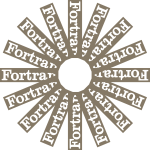Oct 24, 2021

One of my major pet peeves about Fortran is that it contains virtually no high-level access to the file system. The file system is one of those things that the Fortran standard pretends doesn't exist. It's one of those idiosyncratic things about the Fortran standard, like how it uses the word "processor" instead of "compiler", and doesn't acknowledge the existence of source code files so it doesn't bother to recommend a file extension for Fortran (gotta preserve that backward compatibility just in case punch cards come back).
There are various hacky workarounds to do various things that poor Fortran programmers have had to use for decades. Basically, all you have is OPEN, CLOSE, READ, WRITE, and INQUIRE. Here are a few examples:
Deleting a file
Here's a standard Fortran routine that can be used to delete a file:
function delete_file(name) result(istat)
implicit none
character(len=*),intent(in) :: name
integer :: istat
integer :: iunit
open(name=name,newunit=iunit,status='OLD',iostat=istat)
if (istat==0) close(iunit,status='DELETE',iostat=istat)
end function delete_file
As you can see, it's just a little trick, using a feature of CLOSE to delete a file after closing it (but first, we had to open it). Of course, note that the error codes are non-standard (the Fortran standard also doesn't consider this information important and lets the different compilers do whatever they want -- so of course, they all do something different). And of course, there is no exception handling in Fortran either (a post for another time).
Creating a directory
There is absolutely no standard ability in Fortran to create or delete a directory. Again, Fortran basically pretends that directories don't exist. Note that the Intel Fortran Compiler provides a super useful non-standard extension of the INQUIRE statement to allow it to be used to get information about directories. It's a pretty ridiculous state of affairs (Fortran added a bazillion IEEE routines in Fortran 2018 for some reason that nobody needed, but it still doesn't have something like this that everybody has needed for decades). Intel's IFPORT portability module provides many useful (non-standard) routines for accessing the file system (for example DELFILESQQ for deleting files and DELDIRQQ for deleting a directory). I use these all the time and the fact that they are non-standard and not present in other compilers is a major source of annoyance.
For some file or directory operations, you can always resort to using system calls, and thus have to provide different methods for different platforms (of course Fortran provides no standard way to get any information about the platform, so you have to resort to non-standard, possibly compiler-specific, preprocessor directives to do that). For example, to create a directory you could use:
subroutine make_directory(name)
implicit none
character(len=*),intent(in) :: name
call execute_command_line ('mkdir '//name)
end subroutine make_directory
That one was easy because "mkdir" works on macOS, Window, and Linux. See previous post about getting command line calls into strings, which can also be useful for some things like this.
Getting a list of files
How about getting a list of all the files that match a specific pattern? Again, this can be done if you are using the Intel compiler using the IFPORT module GETFILEINFOQQ routine:
function get_filenames(pattern, maxlen) result(list)
use ifport
implicit none
character(len=*),intent(in) :: pattern
integer,intent(in) :: maxlen
character(len=maxlen),dimension(:),allocatable :: list
integer(kind=int_ptr_kind()) :: handle
type(file$infoi8) :: info
integer :: length
allocate(list(0))
handle = file$first
do
length = GETFILEINFOQQ(trim(pattern), info, handle)
if ((handle==file$last) .or. (handle==file$error)) exit
list = [list, info%name]
end do
end function get_filenames
The file$infoi8 type is some super-weird non-standard Intel thing. Note that this example only returns the file names, not the full paths. To get the full path is left as an exercise to the reader. Also note that Fortran doesn't provide a good string class, so we just set a maximum string length as an argument to this function (but note that Intel is only returning a 255-character string anyway).
Final thoughts
There are various libraries out there that can do some of this. For example, M_system (a Fortran module interface for calling POSIX C system routines). Hopefully, a comprehensive set of filsystem routines will eventually make it into the Fortran Standard Library.
See also
Dec 18, 2020

Intel recently released its new oneAPI Toolkit, which had been in beta for a while. According to their documentation, oneAPI includes various products:
The big news here is that this is all now entirely free to use. They are all available for Windows, Linux, and macOS. The Fortran compiler also now includes all of the Fortran 2018 standard. Apparently, Intel will still sell you a license, but it seems the only reason to buy one would be to get the Premier Support.
See also
Dec 18, 2019

Intel has released version 19.1 the Intel Fortran Compiler (part of Intel Parallel Studio XE 2020). According to the release notes, the new version adds a lot of features from Fortran 2018:
- Enhancements to the IMPLICIT statement allow specifying that all external procedures must declared EXTERNAL
- Enhancements to the GENERIC statement permit it to be used to declare generic interfaces
- The locality of variables may now be specified on a DO CONCURRENT statement
- Enhancements to edit descriptor forms E, D, EN, ES, and G allow a field width of zero, analogous to the F edit descriptor
- The exponent width e in a data edit descriptor may now be zero, analogous to a field width of zero
- The RN edit descriptor now rounds to nearest as specified by Fortran 2018 and ISO/IEC/IEEE 60559:2011
- The EX edit descriptor allows for hexadecimal format output of floating point values. Hexadecimal format floating point values are allowed on input.
- SIZE= may be specified for non-advancing I/O
- The values for SIZE= and POS= in an INQUIRE statement for pending asynchronous operations have been standardized
- The value assigned to the RECL= specifier in an INQUIRE statement now has standardized values
- A new form of the intrinsic function CMPLX does not require the KIND= keyword if the first argument is type COMPLEX
- The arguments to the SIGN function may be of different kinds
- INTEGER and LOGICAL arguments to intrinsic procedures are no longer required to be of default kind
- The named constants STAT_FAILED_IMAGE and STAT_UNLOCKED_FAILED_IMAGE have been defined in the intrinsic
ISO_FORTRAN_ENV module
- The non-block DO statement and the arithmetic IF statement are now deleted in Fortran 2018.
- COMMON, EQUIVALENCE and BLOCKDATA statements are now obsolescent
- The labeled form of DO loops is now obsolescent
- Locality of variables in DO CONCURRENT constructs can now be declared on the DO CONCURRENT statement
- Specific names of intrinsic procedures are now obsolescent
- FAIL IMAGE statement allows debugging recovery code for failed images without having to wait for an actual image failure
- The named constants STAT_FAILED_IMAGE and STAT_UNLOCKED_FAILED_IMAGE have been defined in the intrinsic
ISO_FORTRAN_ENV module
- An optional argument STAT= has been added to ATOMIC_REF and ATOMIC_DEFINE intrinsic procedures
- Optional STAT= and ERRMSG= specifiers have been added to the MOVE_ALLOC intrinsic procedure, to image selectors, and to the CRITICAL statement and construct
- Atomic subroutines ATOMIC_ADD, ATOMIC_AND, ATOMIC_CAS, ATOMIC_FETCH_ADD, ATOMIC_FETCH_AND, ATOMIC_FETCH_OR, ATOMIC_FETCH_XOR, ATOMIC_OR, and ATOMIC_XOR have been implemented
- Collective subroutines CO_BROADCAST, CO_MAX, CO_MIN, CO_REDUCE, and CO_SUM have been implemented
- The SELECT RANK construct has been implemented allowing manipulation of assumed rank dummy arguments
- The compiler will now diagnose the use of nonstandard intrinsic procedures and modules as required by Fortran 2018
- Transformational intrinsic functions from the intrinsic modules ISO_C_BINDING, IEEE_ARITHMETIC, and IEEE_EXCEPTIONS are now allowed in specification expressions
- You can now specify the optional argument RADIX for the IEEE_GET_ROUNDING_MODE and IEEE_SET_ROUNDING_MODE intrinsic module procedures
- The optional ROUND argument has been added to the IEEE_RINT function in the intrinsic module IEEE_ARITHMETIC
- The intrinsic module IEEE_ARITHMETIC now includes the functions IEEE_FMA, IEEE_SIGN_BIT, IEEE_NEXT_UP and IEEE_NEXT_DOWN
- The intrinsic module procedures IEEE_MAX, IEEE_MIN, IEEE_MAX_MAG, and IEEE_MIN_MAG have been implemented
- The intrinsic module procedures IEEE_INT and IEEE_REAL have been implemented
- The intrinsic module IEEE_EXCEPTIONS now contains a new derived type, IEEE_MODES_TYPE, which can be used to save and restore the IEEE_MODES using the IEEE_GET_MODES and the IEEE_SET_MODES intrinsic module procedures
- A new rounding mode, IEEE_AWAY has been added
- SUBNORMAL is now synonymous with DENORMAL
- IEEE_QUIET_EQ, IEEE_QUIET_NE, IEEE_QUIET_LT, IEEE_QUIET_LE, IEEE_QUIET_GT, IEEE_QUIET_GE, IEEE_SIGNALING_EQ, IEEE_SIGNALING_NE, IEEE_SIGNALING_GT, IEEE_SIGNALING_GE, IEEE_SIGNALING_LT, and IEEE_SIGNALING_LE intrinsic module procedures have been implemented
The Intel Fortran Compiler has full support for the Fortran 2008 standard and includes most features from the Fortran 2018 standard.
See also
Sep 13, 2018

Intel has just released v19 of the Intel Fortran Compiler (part of Intel Parallel Studio XE 2019). The new release adds some new features from the upcoming Fortran 2018 standard:
- Coarray events
- Intrinsic function coshape
- Default accessibility for entities accessed from a module
- Import Enhancements
- All standard procedures in
ISO_C_BINDING other than C_F_POINTER are now PURE
Presumably, it also include some bug fixes. Intel used to provide a list of bug fixes, but they seem to have stopping doing that for some reason.
See also
Sep 12, 2017

Intel has just released version 18 of the Intel Fortran Compiler (part of Intel Parallel Studio XE 2018). At long last, this release includes full support for the Fortran 2008 standard. The updates since the previous compiler release include:
COMPILER_OPTIONS and COMPILER_VERSION in ISO_FORTRAN_ENV- Complex arguments to trigonometric and hyperbolic intrinsic functions
FINDLOC intrinsic function- Optional argument
BACK in MAXLOC and MINLOC intrinsic functions
- Multiple type-bound procedures in a
PROCEDURE list
- Passing a non-pointer data item to a pointer dummy argument
- Polymorphic assignment with allocatable Left Hand Side (LHS)
- Allocatable components of recursive type and forward reference
- Data statement restrictions removed
In addition, the new release also includes support for all the features from "Technical Specification 29113 Further Interoperability with C", planned for inclusion in Fortran 2015. These include:
- Assumed type (
TYPE(*))
- Assumed rank (
DIMENSION(..))
- Relaxed restrictions on interoperable dummy arguments
ISO_Fortran_binding.h C include file for use by C code manipulating "C descriptors" used by Fortran
Hopefully, it won't take so long to get the compiler up to full Fortran 2015 compliance (see a previous post for a list of new Fortran 2015 features).
See also
Sep 10, 2016

Intel has announced the availability of version 17.0 of the Intel Fortran Compiler (part of Intel Parallel Studio XE 2017). Slowly but surely, the compiler is approaching full support for the current Fortran 2008 standard. New Fortran 2008 features added in this release are:
TYPE(intrinsic-type)- Pointer initialization
- Implied-shape
PARAMETER arrays
- Extend
EXIT statement to all valid construct names
- Support
BIND(C) in internal procedures
In addition, the compiler now also supports the standard auto-reallocation on assignment by default (previously, you had to use a special compiler flag to enable this behavior).
See also
Feb 28, 2016
Some years ago, I needed a Fortran routine to do linear interpolation of a multidimensional (up to 6D) data set. Not wanting to reinvent the wheel, I ended up using a routine called FINT from CERNLIB (documentation here). It is written in Fortran 66, and has some hard-coded limits on the number of dimensions that can be used, but these are not fundamental to the algorithm. With a few minor changes, the routine can be used for interpolation of any number of dimensions. I present below a modern Fortran version that removes the limitations. Note that the original code is GPL licensed, thus so is this modification.
function fint(narg,arg,nent,ent,table)
use iso_fortran_env, only: wp => real64
implicit none
real(wp) :: fint
integer,intent(in) :: narg
integer,dimension(narg),intent(in) :: nent
real(wp),dimension(narg),intent(in) :: arg
real(wp),dimension(:),intent(in) :: ent
real(wp),dimension(:),intent(in) :: table
integer,dimension(2**narg) :: index
real(wp),dimension(2**narg) :: weight
logical :: mflag,rflag
real(wp) :: eta,h,x
integer :: i,ishift,istep,k,knots,lgfile,&
lmax,lmin,loca,locb,locc,ndim
!some error checks:
if (size(ent)/=sum(nent)) &
error stop 'size of ent is incorrect.'
if (size(table)/=product(nent)) &
error stop 'size of table is incorrect.'
if (narg<1) &
error stop 'invalid value of narg.'
lmax = 0
istep = 1
knots = 1
index(1) = 1
weight(1) = 1.0_wp
main: do i = 1 , narg
x = arg(i)
ndim = nent(i)
loca = lmax
lmin = lmax + 1
lmax = lmax + ndim
if ( ndim>2 ) then
locb = lmax + 1
do
locc = (loca+locb)/2
if ( x<ent(locc) ) then
locb = locc
else if ( x==ent(locc) ) then
ishift = (locc-lmin)*istep
do k = 1 , knots
index(k) = index(k) + ishift
end do
istep = istep*ndim
cycle main
else
loca = locc
end if
if ( locb-loca<=1 ) exit
end do
loca = min(max(loca,lmin),lmax-1)
ishift = (loca-lmin)*istep
eta = (x-ent(loca))/(ent(loca+1)-ent(loca))
else
if ( ndim==1 ) cycle main
h = x - ent(lmin)
if ( h==0.0_wp ) then
istep = istep*ndim
cycle main
end if
ishift = istep
if ( x-ent(lmin+1)==0.0_wp ) then
do k = 1 , knots
index(k) = index(k) + ishift
end do
istep = istep*ndim
cycle main
end if
ishift = 0
eta = h/(ent(lmin+1)-ent(lmin))
end if
do k = 1 , knots
index(k) = index(k) + ishift
index(k+knots) = index(k) + istep
weight(k+knots) = weight(k)*eta
weight(k) = weight(k) - weight(k+knots)
end do
knots = 2*knots
istep = istep*ndim
end do main
fint = 0.0_wp
do k = 1 , knots
i = index(k)
fint = fint + weight(k)*table(i)
end do
end function fint
As I recall, I wrote wrappers to this function in order to be able to input the data in a more reasonable format. For example, for a five dimensional data set it is more natural to input the five rank-1 abscissa vectors and the rank-5 ordinate matrix. The disadvantage of this routine is that you have to stuff the ordinate matrix into a vector (as well as stuffing all the abscissa vectors into a single vector). This could also be an advantage in some cases, since Fortran arrays have a maximum rank. For Fortran 90, it was 7, while Fortran 2008 expanded this to 15 (the current Intel Fortran Compiler allows up to 31 as a non-standard extension). If you ever, for example, needed to interpolate 32-dimensional data (assuming you had enough RAM), you could do it with FINT without having to declare any rank-32 matrices. In any event, an example 5D wrapper for FINT is given here:
function fint_5d_wrapper(x,y,z,q,r,&
xvec,yvec,zvec,qvec,&
rvec,fmat) result(f)
use iso_fortran_env, only: wp => real64
implicit none
integer,parameter :: narg = 5
real(wp) :: f
real(wp),intent(in) :: x,y,z,q,r
real(wp),dimension(:),intent(in) :: xvec
real(wp),dimension(:),intent(in) :: yvec
real(wp),dimension(:),intent(in) :: zvec
real(wp),dimension(:),intent(in) :: qvec
real(wp),dimension(:),intent(in) :: rvec
real(wp),dimension(:,:,:,:,:),intent(in) :: fmat
integer,dimension(narg) :: nent
nent(1) = size(xvec)
nent(2) = size(yvec)
nent(3) = size(zvec)
nent(4) = size(qvec)
nent(5) = size(rvec)
f = fint(narg,[x,y,z,q,r],nent,&
[xvec,yvec,zvec,qvec,rvec],&
reshape(fmat,[product(nent)]))
end function fint_5d_wrapper
This works well enough, but note that it isn't very computationally efficient since we are creating temporary copies of the potentially large data arrays (including having to reshape a rank-5 matrix) every time we do an interpolation. While the logic of FINT is a bit hard to fathom, the actual equations are fairly simple (see here, for example). What we really need now is an object-oriented modern Fortran library for multidimensional linear interpolation. Stay tuned...
References
Feb 22, 2016
Intel has released version 16.0.2 of the Intel Fortran Compiler (which is part of Intel Parallel Studio XE 2016). It looks like mainly a bug-fix release. Microsoft Visual Studio 2015 Update 1 is now also officially supported.
References
Aug 25, 2015

Intel just announced the availability of version 16.0 of the Intel Fortran Compiler (part of Intel Parallel Studio XE 2016). New features include:
- Submodules (Fortran 2008)
IMPURE ELEMENTAL (Fortran 2008)EXIT from BLOCK (Fortran 2008)- Full "Further Interoperability with C" implementation from TS29113 (Fortran 2015)
- Improved coarray performance on Linux and Windows
- On Windows, support for Visual Studio 2015
The new "C Descriptor" feature from Fortran 2015 looks pretty awesome, and finally plugs some of the holes in the C interoperability feature first introduced in Fortran 2003. It now allows C code to interact with Fortran pointers, allocatable variables, assumed shape variables, and CHARACTER(*) strings.
I used to be excited about submodules, which have the potential to reduce compilation cascades for very large projects. However, since Intel added the multi-processor compile option on Windows a few versions ago, that has been less bothersome for me. I'll probably try it out anyway, since it also might be useful for organizational purposes (splitting up very large modules into multiple submodules).
See also
- Intel Fortran Compiler 16.0 Release Notes
- What’s New in Intel Fortran 16.0
Jun 30, 2015

Good news for starving students: Intel just announced that their compilers (including the Intel Fortran compiler) are now available under a free, non-commercial license for qualified students on Linux, MacOS X and Windows.




